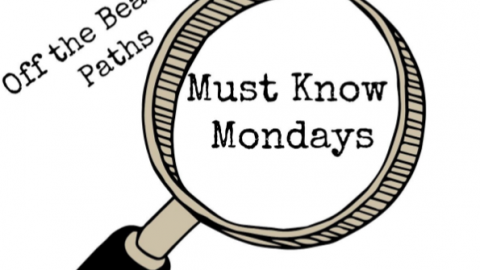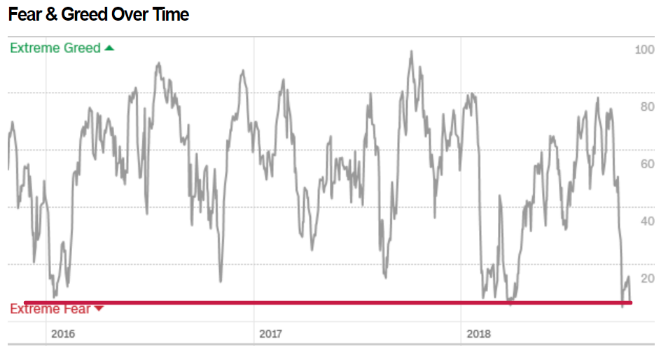Monday’s Census Bureau release of monthly retail sales was said to be softer than forecasted and certainly it was, but why is the question we must ask ourselves. Why because the economy is growing at a 3.5-4% rate with consumer spending and sentiment readings coming in equally as strong through much of the year. So what happened? In order to understand why September retail sales came in well under the forecast we have to take a deeper dive into the presented data and the data from a year ago.
Retail sales rose just 0.1% for the second month in a row, the government said Monday. Wall Street had expected a 0.6% increase, according to Econoday. Excluding automobiles, gasoline, building materials and food services, retail sales jumped 0.5 percent last month. These so-called core retail sales correspond most closely with the consumer spending component of gross domestic product.
Food services and drinking places fell 1.8% from the prior month, followed by gas stations, which dropped 0.8% from August. The decline in dining numbers coincides with the mid-September arrival of Hurricane Florence in the U.S. southeast, particularly in North and South Carolina. Hurricane Florence ravaged the Georgia to Carolina’s seaboard during September likely impacting retail sales during the period. Unfortunately, the U.S. Census Bureau said it could not calculate the impact.
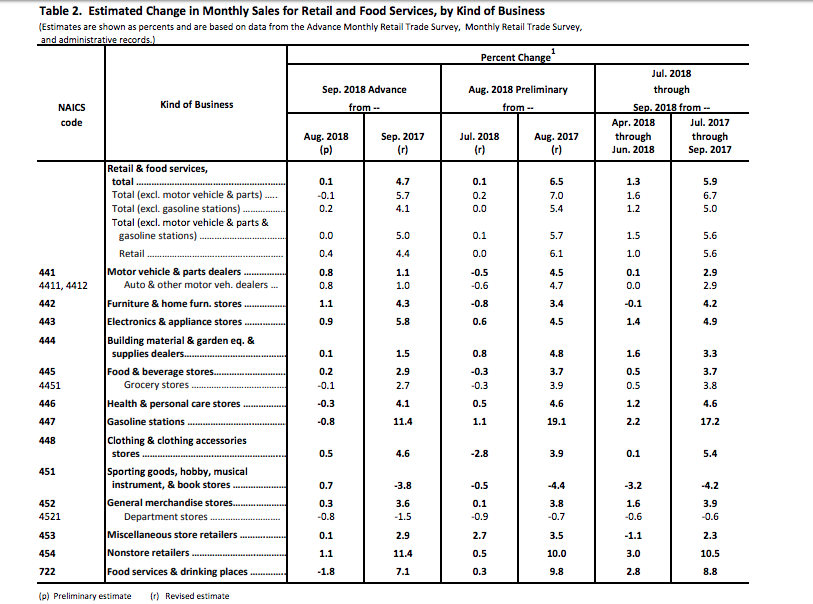
While the Census Bureau can’t offer up a precise measurement of the impact on retail sales from Florence, it is painfully obvious to see the impact that it had in the government’s table above. We’ll separate the data here to focus in on the steep drop in Food Services & Drinking Places.
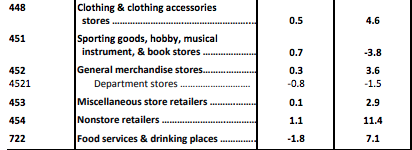
Prior to September’s hurricane impact, spending at restaurants and bars has soared since the early spring, rising to the highest yearly pace in 25 years. Sales of food and drinks purchased outside the home leaped 10.1% in the 12 months from August 2017 to August 2018.
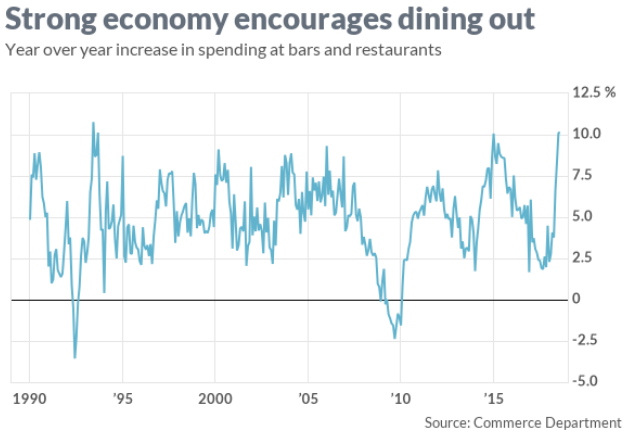
Plainly and simply, the economy doesn’t just come to a screeching halt and spending in such a specific category of retail, such as food services and drinking places, doesn’t either unless there is a significant event, such as a major hurricane in a densely populated region. We can further correlate the decline in Food Services and Drinking Places associated with Hurricane Florence through specific restaurant chains located in these regions. Southern-style restaurant Bojangles (BOJA), for example, whose operations are concentrated in the southeastern U.S., saw its stock fall around 7.7% in September. Also, shares of Carrols Restaurant Group (TAST), which primarily operates along the east coast, with a strong presence in the Carolinas, fell roughly 9.7% over the same period.
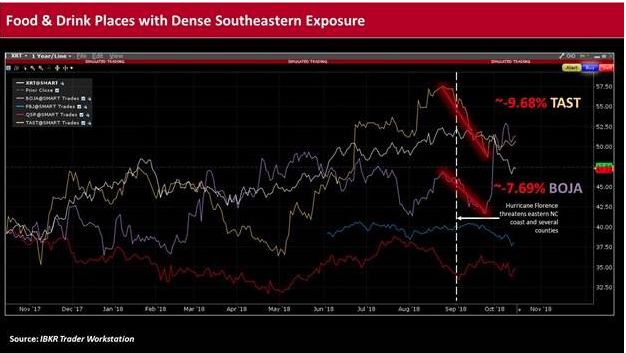
On a month-over-month basis, retail sales were definitively impacted by Hurricane Florence, but the YOY strength remained with total retail sales up 4.7% on a 12-month basis. For all of the concerns regarding auto sales, this category actually performed very well with a .8% MoM gain and 1% YOY gain. What’s important to recognize in the YOY gain is that this segment was also up against a rather tough comparison on a YOY basis. Why? Another hurricane! In September 2017, Auto sales rebounded in part because many Americans had to buy new cars and trucks damaged by Hurricane Harvey and Irma. Even with this outsized comparison from 2017, autos performed very well in September 2018.
September is usually a slow-down month for retail sales, but as one can see in the following chart, September 2017 retail sales had a tremendous spike due to the strength in auto sales as a positive result from Hurricane Harvey and Irma.
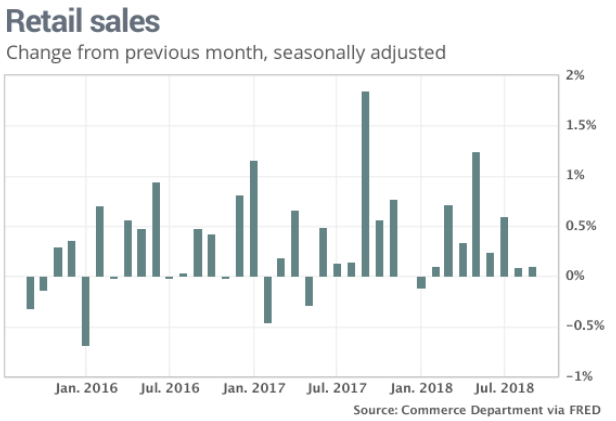
That huge candlestick in September 2017 identifies the positive effects shortly after hurricanes pass and spending resumes as consumers replace belongings…including automobiles. Otherwise, also identified in the chart, September is usually a subdued month for retail sales. As such, we believe the more recent Hurricane Florence impact on retail sales is transitory and nothing suggesting the consumer has slowed in any meaningful way. Every aspect of the data supports this analysis including labor department statistics; we’ll get to that in a moment.
Most categories grew both MoM and all but sporting goods and department stores grew on a YOY basis. We may not see a quick bounce back in the data come October monthly retail sales, given Hurricane Michael’s impact on Florida and the Gulf Coast region.
“The underlying strength and confidence of the consumer still appear to have legs, and consumer spending should remain robust in the coming quarters,” said Jim Baird, chief investment officer at Plante Moran Financial Advisors. “As such, we expect retail sales should bounce back in the coming months.”
“The hurricane in the Carolinas may have been responsible for some of the headline weakness,” wrote economists at CIBC World Markets.
Possibly more importantly in 2018 is how retail sales and the consumer might be impacted by “inflation”. For this discussion we must look at inflation adjusted retail sales.

As shown in the chart above, inflation adjusted retail sales are still rising through all of 2018, even with the PCE moderating higher on the year. This indicates the consumer is well equipped to combat such inflationary concerns put forth by economists.
Lastly, but certainly not least, we can view Hurricane Florence’s impact on retail sales through the Department of Labor statistics. Evidence of Hurricane Florence’s likely economic fallout had shown-up in the September jobs report. The Bureau indicates as such right atop its headline page for release to the public.
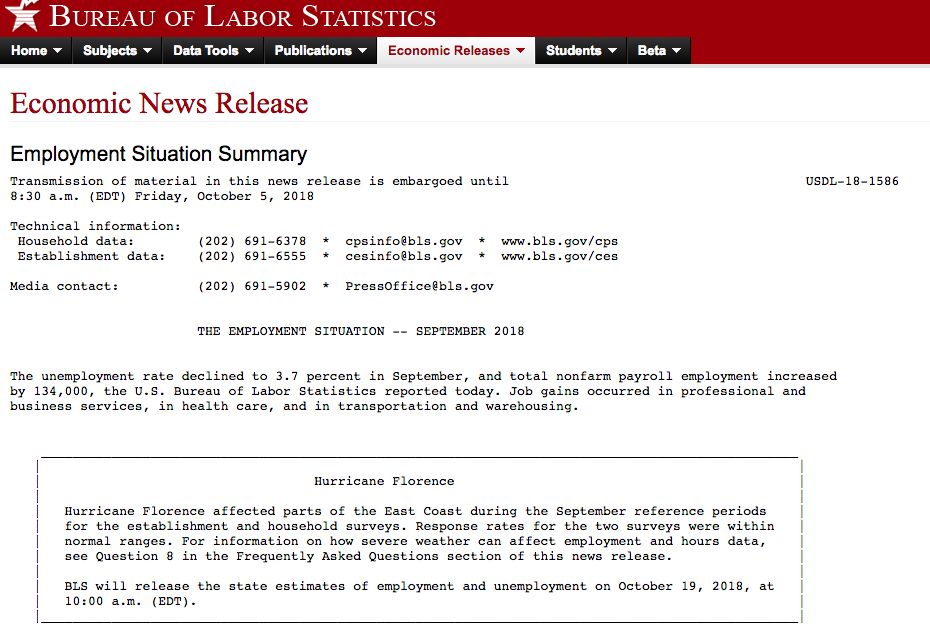
The Bureau of Labor Statistics said that prior to September, jobs in the leisure and hospitality industry had been on a “modest upward trend,” and blamed some of the weakness on the potential impact from the storm. Jobs in that sector were little changed over the month at -17,000.
Jefferies money market economist Thomas Simons noted that the “striking weakness in restaurant sales begs the question of whether this is a harbinger of more weakness to come.” He argues that it is not. Simons said that even “during the worst days of the recession, this category of goods saw strong sales. Consumers will cut vacations and more expensive forms of entertainment before cutting back on the convenience and entertainment of going out to eat.”
The reality of retail sales is that they are still growing at a relatively strong pace YOY, but may prove lumpy given the impact of back-to-back hurricanes in densely populated regions. Hurricane Michael was another devastating storm that will likely impact retail sales for October. Karen Bremer, president, and CEO of the Georgia Restaurant Association, said Michael has affected around 1,500 restaurants in southwest Georgia, but the extent of the damage is still being determined.
Tags: BOJA SPX VIX SPY DJIA IWM QQQ XLY XRT



